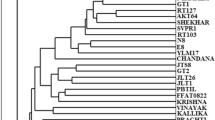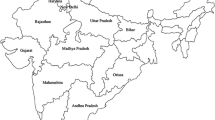Abstract
Sesame (Sesamum indicum L.) is a traditional oil crop cultivated throughout South East Asia. To estimate the genetic diversity of this crop in parts at the region, 22 sesame accessions collected in Vietnam and Cambodia were analyzed using 10 RAPD markers. The 10 primers generated 107 amplification products of which 88 were polymorphic fragments (83%). Genetic diversity of all populations was Ht = 0.34 when estimated by Nei’s genetic diversity and species diversity was H′sp = 0.513 when estimated by Shannon diversity index. Genetic distance ranged from 0.03 to 0.43, with a mean genetic distance of 0.23. The unweighted pair group method with arithmetic averages (UPGMA) cluster analysis for the 22 accessions divided the material in four groups. The dendrogram revealed a clear division among the sesame accessions based on their geographical region. Interestingly, some geographically distant accessions clustered in the same group, which might indicate the human factor involved in the spreading of sesame varieties. The high level of polymorphism shown suggests that RAPD techniques can also be useful for the selection of parents in sesame (Sesamum indicum L.) breeding program and for cultivar differentiation.




Similar content being viewed by others
References
Ashri A (1989) Sesame. In: Roebbelen G, Downey RK, Ashri A (eds) Oil crop of the world. Mc Graw Hill, New York, pp 375–387
Ashri A (1998) Sesame breeding. Plant Breed Rev 16:179–228
Bhat KV, Babrekar PP, Lakhanpaul S (1999) Study of genetic diversity in Indian and exotic sesame (Sesamum indicum L.) germplasm using random amplified polymorphic DNA (RAPD) markers. Euphytica 110:21–33. doi:10.1023/A:1003724732323
Ercan AG, Taskin M, Turgut K (2004) Analysis of genetic diversity in Turkish sesame (Sesamum indicum L.) populations using RAPD markers. Genet Resour Crop Evol 51:599–607. doi:10.1023/B:GRES.0000024651.45623.f2
Ganesh SK, Thangavelu S (1995) Genetic divergence in sesame (Sesamum indicum). Madras Agric J 82:263–265
Hamrick JL, Godt MJW (1989) Allozyme diversity in plants. In: Brown AHD, Clegg MT, Kahler AL, Wei BS (eds) Plant population genetics, breeding and genetic resources. Sinauer, Sunderland, pp 43–63
Isshiki S, Umezaki T (1997) Genetic variations of isozymes in cultivated sesame (Sesamum indicum L.). Euphytica 93:375–377. doi:10.1023/A:1002985625087
Joshi AB (1961) Sesamum. Indian Central Oilseeds Committee, Hyderabad
Karp A, Kresovich S, Bhat KV, Ayad WG, Hodgkin T (1997) Molecular tools in plant genetic resources conservation: a guide to the technologies. IPGRI Tech, Rome
Kim DH, Zur G, Danin-Poleg Y, Lee SW, Shim KB, Kang CW, Kashi Y (2002) Genetic relationships of sesame germplasm collection as revealed by inter-simple sequence repeats. Plant Breed 121:259–262. doi:10.1046/j.1439-0523.2002.00700.x
Kobayashi T, Kinoshita M, Hattori S, Ogawa T, Tsuboi Y, Ishida M, Ogawa S, Saito H (1990) Development of the sesame metallic fuel performance code. Nucl Technol 89:183–193
Koornneef M (1990) Arabidopsis thaliana genetic map. In: Brien SJ (ed) Cold spring harbor laboratory press. Cold Spring Harbor, New York, pp 694–697
Laurentin HE, Karlovsky P (2006) Genetic relationship and diversity in a sesame (Sesamum indicum L.) germplasm collection using amplified fragment length polymorphism (AFLP). BMC Genet 7:1–10. doi:10.1186/1471-2156-7-10
Li M, Midmore DJ (1999) Estimating the genetic relationships of Chinese water chestnut (Eleocharis dulcis (Burm. f.) Hensch.) cultivated in Australia, using random amplified polymorphic DNAs (RAPDs). J Hortic Sci Biotechnol 74:224–231
Liu CJ (1997) Geographical distribution of genetic variation in Stylosanthes scabra revealed by RAPD analysis. Euphytica 98:21–27. doi:10.1023/A:1003026915825
Lynch M, Milligan BG (1994) Analysis of population genetic structure with RAPD markers. Mol Ecol 3:91–99. doi:10.1111/j.1365-294X.1994.tb00109.x
Millan T, Osuna F, Cobos S, Torres AM, Cubero JI (1996) Using RAPDs to study phylogenetic relationships in Rosa. Theor Appl Genet 92:273–277. doi:10.1007/BF00223385
Nayar NM, Mehra KL (1970) Sesame—Its uses, botany, cytogenetics, and origin. Econ Bot 24:20–31
Nei M (1972) Genetic Distance between Populations. Am Nat 106:283. doi:10.1086/282771
Nei M (1978) Estimation of average heterozygosity and genetic distance from a small number of individuals. Genetics 89:583–590
Nei M, Li WH (1979) Mathematical model for studying genetic variation in terms of restriction endonucleases. Proc Nat Acad Sci USA 76:5269–5273. doi:10.1073/pnas.76.10.5269
Popov VN, Urbanovich OY, Kirichenko VV (2002) Studying genetic diversity in inbred sunflower lines by RAPD and isozyme analyses. Genetika 38:937–943
Reiter RS, Young RM, Scolnik PA (1993) Genetic linkage of the Arabidopsis genome: methods for mapping with recombinant inbreds and random amplified polymorphic DNAs (RAPDs). In: Koncz C, Chua NH, Schell J (eds) Methods in Arabidopsis research. World Scientific Publishing, Singapore, pp 170–190
Salazar B, Laurentin H, Davila M, Castillo MA (2006) Reliability of the RAPD technique for germplasm analysis of sesame (Sesamum indicum L.) from Venezuela. Interciencia 31:456–460
Salem HH, Ali BA, Huang TH, Qin DN, Wang XM, Xie QD (2007) Use of random amplified polymorphic DNA analysis for economically important food crops. J Integr Plant Biol 49:1670–1680. doi:10.1111/j.1744-7909.2007.00582.x
Schontz D, Rether B (1999) Genetic variability in foxtail millet, Setaria italica (L.) Beauv.: identification and classification of limes with RAPD markers. Plant Breed 118:190–192. doi:10.1046/j.1439-0523.1999.118002190.x
Stankiewicz M, Gadamski G, Gawronski SW (2001) Genetic variation and phylogenetic relationships of triazine resistant and triazine susceptible biotypes of Solanum nigrum analysis using RAPD markers. Weed Res 41:287–300. doi:10.1046/j.1365-3180.2001.00238.x
Warwick SI, Gugel RK (2003) Genetic variation in the Crambe abyssinica—C. hispanica—C. glabrata complex. Genet Resour Crop Evol 50:291–305. doi:10.1023/A:1013988102576
Weising K, Nybom H, Wolff K, Kahl G (2005) Evaluation of molecular marker data. DNA fingerprinting in plant: principles, methods, and applications. CRC, Boca Raton, pp 207–233
Weiss EA (1971) Castor, sesame and safflower. Leonard Hill, London, pp 311–525
Weiss EA (1983) Oilseed crops. Longman, London, pp 282–340
Williams JGK, Kubelik AR, Livak KJ, Rafalski JA, Tingey SV (1990) DNA polymorphisms amplified by arbitrary primers are useful as genetic markers. Nucl Acids Res 18:6531–6535. doi:10.1093/nar/18.22.6531
Xu DH, Gai JY (2003) Genetic diversity of wild and cultivated soybeans growing in China revealed by RAPD analysis. Plant Breed 122:503–506. doi:10.1046/j.0179-9541.2003.00911.x
Yeh FC, Boyle TJB (1997) Population genetic analysis of co-dominant and dominant markers and quantitative traits. Belg J Bot 129:157
Yermamos DM (1980) Sesame. In: Fehr WR, Hadley HH (eds) Hybridization of crop plants. Am Soc Agron, CSSA, Madison
Yu G, Ma H, Xu Z, Ren L, Zhou M, Lu W (2004) Cloning a DNA marker associated to wheat scab resistance. J Appl Genet 45:17–25
Acknowledgements
This project was supported by the Swedish International Development Agency (SIDA/SAREC). Susanne Hjerdin and Helen Lindgren are acknowledged for technical assistance and Mulatu Geleta for helpful suggestions on using the NTSYSpc and Popgene programs.
Author information
Authors and Affiliations
Corresponding author
Rights and permissions
About this article
Cite this article
Pham, T.D., Bui, T.M., Werlemark, G. et al. A study of genetic diversity of sesame (Sesamum indicum L.) in Vietnam and Cambodia estimated by RAPD markers. Genet Resour Crop Evol 56, 679–690 (2009). https://doi.org/10.1007/s10722-008-9393-z
Received:
Accepted:
Published:
Issue Date:
DOI: https://doi.org/10.1007/s10722-008-9393-z




